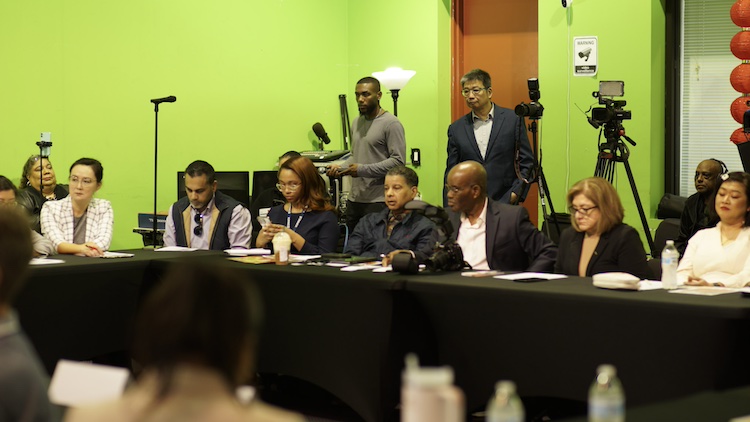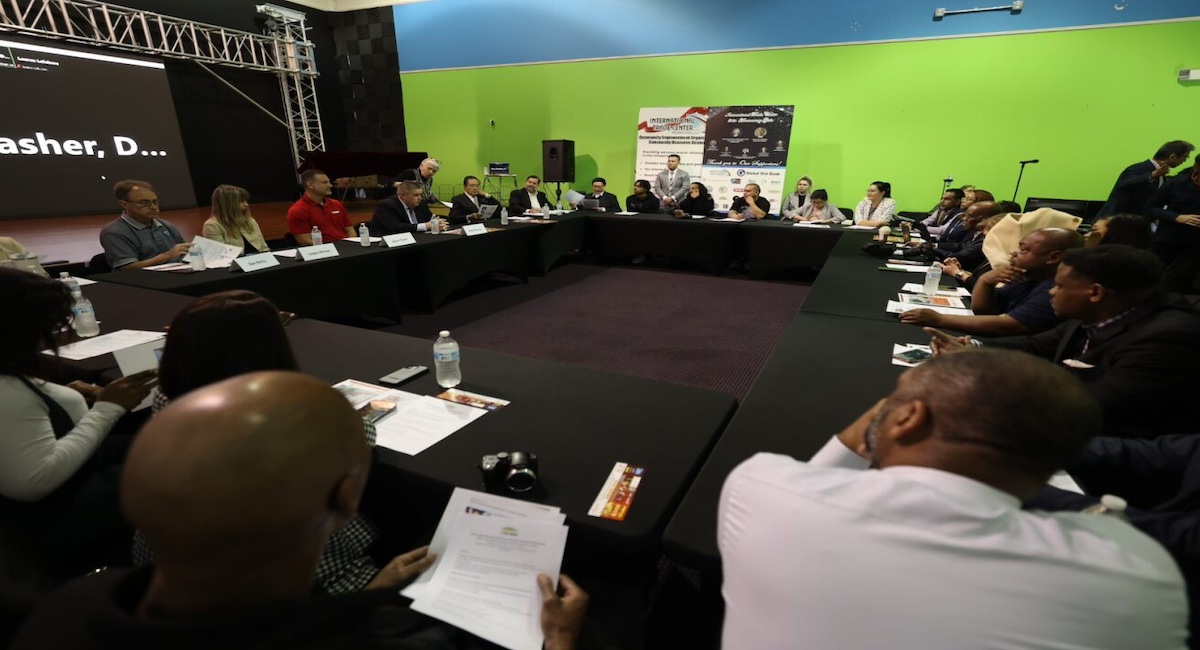HOUSTON – In a significant gathering at Southern News Group in southwest Houston, nearly 40 reporters from diverse, multilingual media outlets attended the Houston Ethnic Media roundtable on January 30. The event, led by FEMA, centered on educating the public about winter preparedness, especially crucial as the third anniversary of Winter Storm Uri approaches. This roundtable provided a valuable platform for diverse media outlets to gain insights and prepare informative content for their audiences, which will be crucial in ensuring preparedness and safety.

Panelists:
- Traci Brasher, FEMA Deputy Regional Administrator in Region 6
- Brian Murray, Harris County Office of Homeland Security and Emergency Management
- Logan Perkes, FEMA Region 6 Disability Integration Specialist
- Dan Reilly, National Weather Service Houston/Galveston
- Jason Tudor, AARP Natural Disasters Manager
Sandy Close, Executive Director, Ethnic Media Services, opened the session by highlighting the importance of an “accessible network of ethnic news outlets serving the diverse communities of the Greater Houston metropolitan area.”
Juan Ayala, Deputy Director of Region 6 External Affairs, expressed FEMA’s enthusiasm for engaging with new media outlets, stating, “The opportunity to meet with new media outlets like this today is a tremendous opportunity for FEMA and we hope it is just the beginning.”
Opening address from FEMA
Traci Brasher, FEMA Deputy Regional Administrator in Region 6, provided the opening address via Zoom. Before delving into FEMA’s #WinterReady campaign, she outlined some enhancements the agency recently made. She remarked:
“As some of you may know, over the last few years, FEMA has prioritized equity in our approach to disaster assistance across all our programs. The bottom line is we need to meet people where they are. We also want to ensure that underserved communities are receiving the help they need to recover.
“Just over a week ago, we announced significant updates to our Individual Assistance program which helps individuals and families recover after disasters. These changes include quicker access to needed funds, expanded eligibility for property and home repairs, and an easier application process for survivors to jumpstart their recovery from disasters. These changes are the most significant updates to survivor assistance in the last 20 years.
“In the past, the limitations of federal assistance have delayed disaster recovery for too many, especially communities that are disproportionately affected by disasters.
“Last November, FEMA published Achieving Equitable Recovery: A Post-Disaster Guide for Local Officials and Leaders. This is a first of its kind framework to help rebuild communities in a more accessible, inclusive, and equitable manner.
“These are steps in the right directions, but we still have work to do.
“So, as I have said, we need to meet people where they are and this time of year, that means preparing them for winter weather.”
Panel Discussion Highlights

Logan Perkes, FEMA Region 6 Disability Integration Specialist, stressed the importance of preparedness planning for people with disabilities. She provided detailed advice on ways to plan and help others in vulnerable situations prepare.
“One of the things that, for people with disabilities, to be a good practice would be having a written list of emergency contacts, the medications they take and any medical information first responders need to know in case anything did happen in an emergency.
“Always request a 90-day supply of medications. That way they have extra on hand in case there is severe weather, and they can’t leave home. And then when they are building an emergency kit, they can purchase items over time because some people are living off $900 a month so they can’t spend $100 buying food and supplies all at one time.
“If physical assistance is needed, shutting off water to the house, carrying bottled water, transporting medical equipment, identifying a person ahead of time who may be able to help, so that can be a neighbor, a family member or a friend who may can come over before a storm is coming and help.”
——————————————
Brian Murray from Harris County Office of Homeland Security and Emergency Management discussed the office’s comprehensive communications strategy, emphasizing the integration of accessibility and language inclusivity in their messaging, particularly concerning winter weather.
He also answered an attendees’ question on what efforts the city is making to help homeless individuals during weather situations:
“People who are generally outside do not necessarily have resources, so we do a couple of things.
“Number one, the Harris County Sheriff’s office has a homeless outreach team that will go out and proactively seek people out. They will offer them possible supplies and will also take them to missions and shelters as they are available.
“We also work with some of the other agencies that specialize in helping people and families who are experiencing homelessness to try and get them indoors as best they can. There is a lot that goes on to try and proactively reach out to those communities. That includes not only the folks that you may see downtown, but there’s numerous encampments of people experiencing homelessness throughout the county. They will go out there, determine what the need is and try to make arrangements for as many people as possible. It’s important to know that we will go out and ask, ‘do you want help’ because they just can’t force them to do anything, but there’s an extensive effort that goes into that before each and every large-scale incident, especially any weather incident that we are aware of.”
———————————
Dan Reilly of the National Weather Service Houston/Galveston spoke about the expected weather patterns influenced by El Niño and highlighted the NWS’s efforts to expand their reach in underserved communities. He spoke about the need to partner with ethnic media outlets to help with diverse populations, in addition to his agency’s focus on language barriers.
“The City of Houston has some preparedness guides in Spanish, Chinese, Vietnamese and so on, but maybe we can do better than that and work as a group. Maybe we can partner with Harris County and Houston Ethnic Media to come up with materials that can serve your communities. We really do want to engage, and I am hearing your willingness to engage with the group here, so that is why we are here today.
“Another thing I want to mention on the National Weather Service side for communicating, there is a website, weather.gov/translate and that is an effort to take weather service products, and by AI (artificial intelligence) translate them into different languages. Right now, the Houston office is not part of that experiment but that will change soon. We expect to be added to Spanish and Vietnamese. Once that effort is underway, it will be important to quality control that. To have Vietnamese speakers, for example, that can look at the translated materials and give feedback and say, ‘That’s just not right or that’s not accurate.”
———————————-
Jason Tudor from AARP, focusing on older Americans, detailed AARP’s initiatives in disaster resilience and preparation. He shared insights into AARP’s response to previous disasters and their ongoing partnership with FEMA and the American Red Cross, particularly.
“If you remember back in 2017, the Houston area experienced the worst, most disastrous flooding in its history. Houston wasn’t the only place in the United States in North America that was affected that year by disasters. We also had the hurricanes in Florida and Puerto Rico, where we saw nursing home patients in Puerto Rico die in their beds because they were without power for more than 10 days.
“We saw thousands of Puerto Ricans dying after Hurricane Maria because of lack of access to power and emergency services. Shortly after that, in the following year, we saw in the campfire in California, people dying in their homes, in their wheelchairs burning to death because they couldn’t evacuate. AARP said ‘enough, we have to change the way older adults are included in emergency planning and disaster resilience education and services.’ So, the following year, we partnered with FEMA and said ‘let’s figure out what’s going wrong. What are the gaps in education and what are the gaps in planning that we need to fill so that this doesn’t happen again?
“In the great freeze here in Texas, over 60 percent of the deaths were people 60 years and older.
“In Katrina, 70 percent of the deaths were people 65 years and older and there are reasons why they are disproportionately impacted.
“So, we have got to do a better job of educating people where they are and connecting to them the resources available to them. We’ve also got to do a better job of making sure there are resources available for them to go to. Are our shelters prepared to take in caregivers? If they aren’t willing to go to a shelter, are we willing to put up the money to make sure they can go to a hotel because what we have found is that older adults are more willing to evacuate if they know that there is a specific hotel room that they are going to go to. If not, then they are going to stay home, so in Florida, for example, they are putting out the money to make sure that there are plenty of hotel rooms available and they are prioritizing older adults to make sure they have access to them. So, there is plenty of different ways that we can start addressing this, we’re just at the beginning of it.”
Helpful resources:





